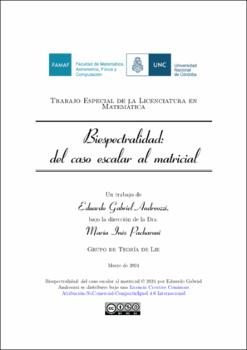| dc.contributor.advisor | Pacharoni, María Inés | |
| dc.contributor.author | Andreozzi, Eduardo Gabriel | |
| dc.date.accessioned | 2024-04-04T16:47:08Z | |
| dc.date.available | 2024-04-04T16:47:08Z | |
| dc.date.issued | 2024-03-27 | |
| dc.identifier.uri | http://hdl.handle.net/11086/551321 | |
| dc.description | Tesis (Lic. en Matemática)--Universidad Nacional de Córdoba, Facultad de Matemática, Astronomía, Física y Computación, 2024. | es |
| dc.description.abstract | Empezamos estableciendo las bases de la teoría de los polinomios ortogonales matriciales. Con esto nos referimos al estudio de la sucesión de polinomios que resultan del proceso de ortogonalización de Gram-Schmidt a partir de un producto interno matricial particular definido por un peso matricial positivo W soportado en un intervalo real determinado. Además, estudiamos en detalle el álgebra D(W) de los operadores lineales diferenciales que tienen a esta familia de polinomios como autofunciones, definiendo en el proceso la noción de operador diferencial simétrico. También daremos una vista rápida pero detallada del Problema Biespectral, en una versión escalar y bastante general. Por último, abordaremos el Problema de Time-Band-Limiting Matricial, cuyo ingrediente clave es la propiedad biespectral que satisfacen algunos de sus agentes principales. | es |
| dc.description.abstract | We begin by establishing the foundations of the theory of matrix-valued orthogonal polynomials. By this we refer to the analysis of the sequence of polynomials arising from the Gram-Schmidt orthogonalization process built upon a specific matrix-valued inner product, in turn defined by a matrix-valued weight density function W supported on some real interval. We also review in detail the algebra D(W) of linear ordinary differential operators possessing the aforementioned polynomials as eigenfunctions, defining in the process the notion of a symmetric differential operator. Next we give a quick but thorough overview of the Bispectral Problem, in a scalar and mostly general version. Lastly, we tackle the matrix version of the Time-Band-Limiting Problem, whose crucial ingredient is the bispectral property satisfied by some of its main agents. | en |
| dc.language.iso | spa | es |
| dc.rights | Attribution-NonCommercial-ShareAlike 4.0 International | * |
| dc.rights.uri | http://creativecommons.org/licenses/by-nc-sa/4.0/ | * |
| dc.subject | Funciones especiales | es |
| dc.subject | Polinomios ortogonales matriciales | es |
| dc.subject | Funciones ortogonales y polinomios | es |
| dc.subject | Pesos matriciales | es |
| dc.subject | Álgebra de operadores diferenciales | es |
| dc.subject | Biespectralidad | es |
| dc.subject | Special functions | en |
| dc.subject | Orthogonal polynomials and functions of hypergeometric type | en |
| dc.subject | Eigenfunctions, eigenfunction expansions, completeness of eigenfunctions of ordinary differential operators | en |
| dc.subject | Harmonic analysis on euclidean spaces | en |
| dc.subject | Orthogonal functions and polynomials | en |
| dc.subject | Algebras of specific types of operators | en |
| dc.subject | Application of orthogonal and other special functions | en |
| dc.subject | Ad conditions | en |
| dc.subject | Time band limiting | en |
| dc.title | Biespectralidad : del caso escalar al matricial | es |
| dc.type | bachelorThesis | es |
| dc.description.fil | Fil: Andreozzi, Eduardo Gabriel. Universidad Nacional de Córdoba. Facultad de Matemática, Astronomía, Física y Computación; Argentina. | es |





